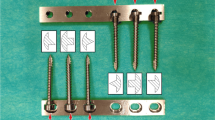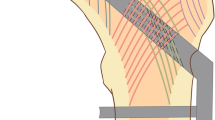Abstract.
The twin hook has been developed as an alternative to the conventional lag screw to be combined with a barrelled side-plate in the treatment of trochanteric hip fractures. With two oppositely directed apical hooks introduced into the subchondral bone of the femoral head, the twin hook provides different stabilising properties to the lag screw. The femoral head purchase of the twin hook and the lag screw were compared in a biomechanical study using artificial cancellous bone, and responses to axial and torsional loading was determined. A distinct yield point in load and torque was noted for the lag screw, representing failure of the laminas supporting the threads. For the twin hook, gradual increase of load and torque occurred during impaction of the bone supporting the hooks. The peak loads and torques were higher for the lag screw, but were similar for both devices after 8 mm deformation. The stiffness was higher for the lag screw, but in counter-clockwise rotation the stiffness for the lag screw was negligible. The twin hook appeared to provide fixation stability comparable to that offered by the lag screw, but with conceivable advantages in terms of a deformation response involving bone impaction and gradually increasing stability.
Résumé.
Le «Twin Hook» a été proposé comme une alternative à la vis de traction coulissante en association avec les plaques en tube dans le traitement des fractures trochantériennes de la hanche. Grace aux 2 crochets venant en direction opposées se fixer dans l'os sous-chondral le «Twin Hook» apporte des qualités de stabilité différentes de celles de la vis classique. La tenue dans la tête fémorale du «Twin Hook» et de la vis en traction ont été comparées dans une étude biomécanique utilisant de l'os spongieux artificiel; les resistances aux forces en compression ou en torsion ont été determinées. Un point de rupture tant en compression qu'en torsion a éte constaté pour la vis en traction, correspondant à l'altération du support du filetage. Pour le «Twin Hook» une augmentation progressive de la compression et de la torsion a été observée lors de l'impaction de l'os supportant les crochets. Les forces maximales en compression et torsion étaient supérieures pour la vis en traction, mais égales pour les deux mécanismes après une déformation de 8 mm. La rigidité était supérieure pour la vis en traction, mais en rotation inverse à celle des aiguilles d'une montre la rigidité de la vis en traction était négligeable. Le «Twin Hook» a montré qu'il établit une stabilité dans sa fixation comparable a celle offerte par la vis en traction, ceci avec des avantages probables en ce qui concerne la réponse à la déformation avec une augmentation progressive de la stabilité.
Similar content being viewed by others
Author information
Authors and Affiliations
Additional information
Electronic Publication
Rights and permissions
About this article
Cite this article
Olsson, .O., Tanner, .K., Ceder, .L. et al. A biomechanical study on fixation stability with twin hook or lag screw in artificial cancellous bone. International Orthopaedics (SICOT) 26, 349–355 (2002). https://doi.org/10.1007/s00264-002-0385-x
Accepted:
Issue Date:
DOI: https://doi.org/10.1007/s00264-002-0385-x




